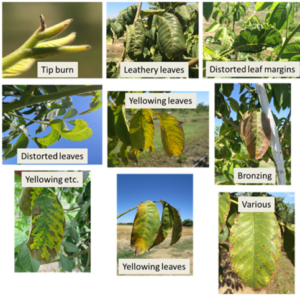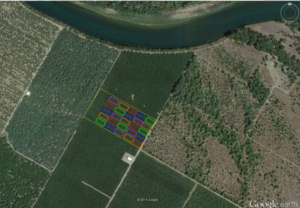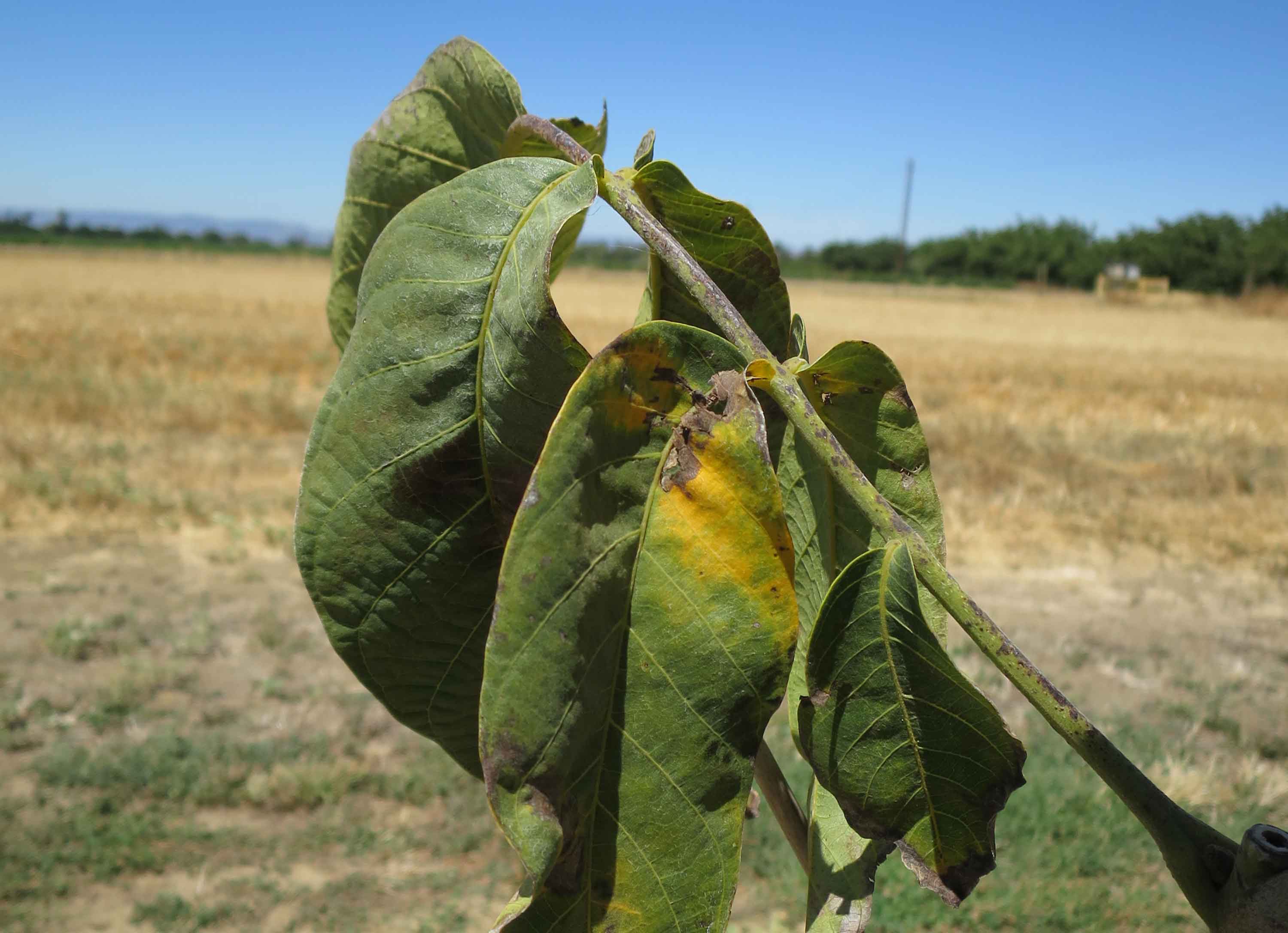Overly aggressive, early irrigation can saturate soils and deprive roots of necessary oxygen to grow. Soil fungal pathogens such as Phytophthora thrive in saturated soils and can infect tree roots. The result is declining tree health, productivity, and higher incidence of tree death. Figure 1 displays an assortment of disorders that have been observed and associated with extended periods of overly wet soil conditions, particularly in the spring (April, May, and early June). When orchard water stress is monitored with a pressure chamber and midday stem water potential (SWP) levels are steadily near or above predicted baseline levels for fully irrigated conditions, these types of disorders are more likely to occur.

Figure 1. A variety of plant disorders: tip burn, leathery and yellowing leaves, and bronzing have been observed and associated with over-irrigation. (Photos and observations courtesy of Bruce Lampinen).
Delaying the start of irrigation too long can result in trees that are stressed from the lack of water. Impacts may include a decline in shoot growth and a visible reduction in the rate of nut sizing after flowering. Smaller walnuts may cause declines in yield as a result of lower kernel weight. When delays in spring irrigation are followed by inadequate irrigation in the summer and fall, it may lead to even higher crop water stress and more impact on kernel weight, color, and bud development for next year’s crop.
Experimenting with Irrigation Start Date
A randomized and replicated experiment has been sponsored by the California Walnut Research Board since 2014 in a commercial Chandler/Paradox walnut orchard. Figure 2 uses a Google Earth image to illustrate the general experimental layout.

Figure 2. General layout of UC irrigation experiment in a commercial walnut orchard. A randomized and replicated experiment evaluating a wide range in irrigation start dates. Rectangles of same color are ½ acres plots where the irrigation start date was initiated at similar levels of orchard water stress. (Illustration prepared by Ken Shackel).
The experiment is located in the northern Sacramento Valley near Red Bluff, California. In 2014, the orchard was 9 years old. The orchard planting configuration is 28 by 18 feet. Soils are well drained, Columbia silt loam and fine sandy loam. A solid set minisprinkler system is used to apply irrigation water. Mechanical hedging has been practiced since 2012 with every fourth center hedged annually. Supplemental hand pruning has been practiced primarily to control the size of every other tree in anticipation of tree removal to increase tree spacing in the orchard. Tree spacing was closer to achieve earlier orchard production but wider tree spacing is of interest over the life of the orchard to optimize light and humidity in the orchard and lessen pressure from various foliar diseases that can infect buds, flowers, and nut set.
In this experiment, a large window of time (more than 90 days after leafout) has been evaluated to observe the effect of irrigation start on Chandler walnut. There are many objectives in performing this experiment ranging from improving our understanding of physiological responses of walnut to different levels of water stress, to field testing and determining the accuracy of automated devices for monitoring plant water stress. This article focuses on one key objective which is to test five threshold levels of SWP measured with a pressure chamber as indicators for optimizing the decision of when to begin the irrigation season.
Effect of Crop Water Stress Level on Irrigation Start Date, Yield, and Water Savings
Table 1 summarizes the five SWP thresholds that were evaluated in this experiment and the effect on timing the start of irrigation. The SWP thresholds included irrigating when SWP was near the fully irrigated baseline which indicates no crop stress; and delaying start of irrigation until SWP averaged at least 1.0, 2.0, 3.0 or 4.0 bar(s) below baseline for two consecutive measurements.1 This range in midday SWP levels corresponds with minimal to severe levels of walnut water stress. Irrigation start dates began as early late April and have been delayed as late as early July. Said differently, the earliest start of irrigation began about 30 days after Chandler leafout, the intermediate stress levels triggered the start of irrigation 40 to 80 days after leafout, and the most extreme stress levels delayed the start of irrigation for about 90 days. After the first irrigation was applied on all treatments, the plots were irrigated with the same amount, frequency, and duration of water for the remainder of the season.
Table 1. Cumulative, three-year effects of orchard water stress levels on irrigation start date, dry in-shell yield, and relative water savings measured in 2014, 2015, and 2016.
|
Tree Stress Just Before First Irrigation (bars below baseline) |
Approximate Irrigation Start Date |
Approximate Days After Leafout |
Dry In-shell Yield (lbs/acre) |
Yield Loss % of highest yield | Relative
Water Savings (%) |
| At or Near Fully Irrigated Baseline1 | Late April to Early May | 25 to 35 | 14,051 a 2 | 0 % | 0 |
| 1.0 | Mid to Late May | 45 to 60 | 13,780 ab | -2 % | 10 |
| 2.0 | Early to Mid June | 60 to 75 | 12,925 ab | -8 % | 19 |
| 3.0 | Mid to Late June | 75 to 85 | 12,591 ab | -10 % | 34 |
| 4.0 | Late June to Early July | 85 to 95
|
11,827 b | -16 % | 30 |
1 The fully irrigated baseline represents no tree water stress when soil moisture in the root zone is not depleted at all. For more information about the baseline concept and how to predict it refer to http://informatics.plantsciences.ucdavis.edu/Brooke_Jacobs/index.php
2 Dissimilar alphabetic letters indicate average yields that are significantly different.
Table 1 also shows cumulative dry-inshell yields from 2014 through 2016. After three years, there has been a statistically and economically significant separation in dry in-shell walnut yield between plots where irrigation was started the earliest and the latest (start at or near baseline versus 4.0 bars below baseline or about 30 versus 90 days after leafout). Cumulative dry in-shell yield averaged 2224 lbs per acre or 16 percent less using a 4.0 bar below baseline threshold compared to starting irrigation at or near baseline. Cumulative dry in-shell yields in the plots where intermediate thresholds of 1.0, 2.0, and 3.0 bars below baseline were used to trigger the first irrigation were not consistently lower and statistically different from the earliest irrigation start date. Cumulative yields in the 1.0 bar below baseline plots averaged 271 lbs per acre or 2 percent less than the earliest start date. Cumulative yields in the 2.0 and 3.0 bar below baseline averaged 1,126 and 1460 lbs per acre or 8 and 10 percent lower yields, respectively. While, these yield reductions were not consistent enough to be statistically significant they may be economically important. More seasons are needed to evaluate longer term effects on tree loss, orchard longevity, and consistency of production. If less tree loss occurs over the long term in walnuts when one or more of these intermediate tree stress levels are used to trigger the start of the irrigation season, the economics could shift to favor a modest delay in the start of irrigation.
A last point from Table 1 is the potential to save on water and energy costs by modestly delaying the start of irrigation to one of these intermediate water stress levels. In this experiment, it was possible to reduce irrigation at least 10 percent and possibly more without serious short term impacts on yield. This is worth remembering if faced with water shortages or high pumping costs in the future.
Effect of Crop Water Stress and Irrigation Start Date on Walnut Quality
Table 2 summarizes the effect of early season orchard water stress and irrigation start on walnut quality. The results from all three years have consistently shown that nut weight and nut size can be affected significantly by delaying irrigation too long. In this experiment, crop water stress levels at baseline and as much as 2.0 bars below baseline which correspond to irrigation start dates ranging from about 30 to at least 60 days after leafout had no consistent or statistically significant effect on nut weight, percent large sound, or percent jumbo and large walnuts. When irrigation start was delayed more than 75 days to allow crop water stress levels to reach 3.0 and 4.0 bars SWP, nut weight, percent large sound, and percent jumbo and large walnuts were all significantly reduced to levels that could affect price. All other walnut quality characteristics such as kernel color (RLI), mold, shrivel, and percent edible kernel were not affected by early season crop water stress and the decision of when to begin irrigation.
Table 2. Effect of early season orchard water stress on Chandler walnut quality. Values are averages over all three years.
| Tree Stress Just Before First Irrigation
(bars below baseline) |
Approximate Irrigation Start Date |
Nut Weight (grams) |
Percent Large Sound |
Percent Jumbo and Large |
RLI |
Percent Mold |
Percent Shrivel |
Percent Edible Kernel |
| At or Near Fully Irrigated Baseline1 | Late April to Early May |
10.4 a |
79.1 a |
77.4 a |
54.5 |
1.3 |
2.3 |
45.5 |
|
1.0 |
Mid to Late May |
10.1 ab |
75.7 ab |
73.5 ab |
55.1 |
1.3 |
2.6 |
45.7 |
|
2.0 |
Early to Mid June |
10.1 ab |
75.6 ab |
73.5 ab |
55.0 |
1.6 |
1.8 |
45.4 |
|
3.0 |
Mid to Late June |
9.7 bc |
68.3 bc |
66.7 bc |
54.4 |
1.8 |
2.5 |
45.8 |
|
4.0 |
Late June to Early July |
9.3 c |
57.7 c |
57.7 c |
54.7 |
1.6 |
2.7 |
46.1 |
Effects of Delayed Irrigation Start on Deep Soil Moisture
Despite worries that delaying the start of irrigation in the spring would result in depleted moisture leading to more severe stress later in the summer when cutoff for harvest occurs, this has not been the case. The plots that started irrigation in early to late June were actually less stressed following cutoff of irrigation for harvest than were the treatments that had initiated irrigation in late April and early May in all years of the experiment. This suggests that the trees with delayed spring irrigation may have improved root growth and/or the spring vegetative growth slowed earlier in the season allowing more time for the walnuts to develop and mature and, thus, less stress at harvest.
More in-depth results from this experiment can be found in the report to the California Walnut Board, (http://ucanr.edu/repositoryfiles/2015-115-160270.pdf).
Highlights from the Experiment
Review of this irrigation experiment is not intended to suggest that the start of the irrigation season can be delayed for long periods of time for every walnut orchard. It does indicate that there may be a 30 to 60 day window after leafout to begin irrigation. When optimized, it can protect tree root health from over-irrigation, avoid too much crop stress from the lack of water, and reduce irrigation water needs and energy costs. Determining how much the first irrigation can be delayed in specific orchard conditions needs to be determined by measuring walnut water stress levels with a pressure chamber or with another reliable indicator of orchard water stress.
Tools to Help Make Irrigation Decisions
A variety of irrigation management tools can help make orchard specific decisions about when to begin the irrigation season. Using at least two of these monitoring tools in combination is encouraged because each tool has limitations.
Starting Irrigation based on ETc and Rainfall
One approach is to track estimates of evapotranspiration (ET) that reflect current weather and compare it to the amount of spring rainfall received since leafout. The first irrigation is not necessary until the cumulative ET exceeds the amount of spring rainfall received since leafout by at least the amount of water that will be applied in a typical irrigation event (usually 18 to 24 hours of irrigation with pressurized systems). If there is concern about tree loss from root diseases and saturated soils, the first irrigation can be delayed even longer until the difference between cumulative ET and spring rainfall is equivalent to 2 to 4 irrigation events or 36 to 96 hours of irrigation. This approach requires knowing the hourly water application rate of the irrigation system. It can also be problematic in some years because root development and rooting depth can vary depending on winter and spring rainfall and soil temperatures, and this can lead to different levels of early season water stress in walnuts in different years.
Growers in the Sacramento Valley can subscribe online to receive weekly, real-time, regional ET reports during the irrigation season by email at http://www.sacvalleyorchards.com/subscribe/. If assistance is needed contact aefulton@ucanr.edu or dmlightle@ucanr.edu for Tehama, Butte, and Glenn Counties, jkhasey@ucanr.edu for Sutter and Colusa Counties, or kspope@ucanr.edu for Sacramento, Solano and Yolo Counties: Growers in the San Joaquin Valley can request this information from raduncan@ucanr.edu for the northern San Joaquin Valley area; and blsanden@ucanr.edu in Kern County for the southern San Joaquin Valley.
Starting Based on Soil Moisture
There are numerous manufacturers and providers of soil moisture sensing equipment. Some detect volumetric soil moisture content and some measure soil moisture tension. Soil moisture levels can be measured manually or automatically with dataloggers and delivered on demand via cellular and internet services. An important aspect of monitoring soil moisture depletion is placement of the soil sensors to achieve good representation of the root zone and soil variability. The decision to begin the irrigation season can be determined by comparing the amount of soil moisture depletion to the amount of irrigation that will be applied and balancing them. Irrigation should begin before 50 percent of the plant available soil moisture is depleted in the root zone.
Starting Based upon Orchard Water Status
The pressure chamber and midday stem water has been the state of the art for monitoring tree water stress for some time. Sustained levels approaching 2 bars below the fully irrigated baseline in walnut are a reasonable threshold to begin irrigation. A free on-line UC ANR Publication 8503 describes in detail how to use the pressure chamber to guide water management decisions in walnut.
















